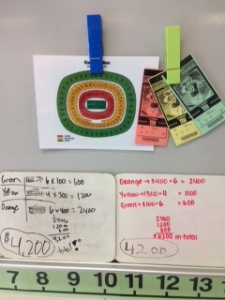Last week my 7th grade students looked at combining like terms. As a visual introduction, I handed each student one of three different colored “tickets” to a Giants game. I presented the students with this scenario: “An anonymous donor bought tickets for the entire class to go to a Giants game. Unfortunately, not all the seats are in the same area.” I put a map of MetLife stadium on the board showing the different seating areas. The different colored tickets showed the seat number, level, and the price of the ticket. Green tickets were seats in the upper level, yellow tickets were seats in the mezzanine level, and orange tickets were seats in the lower level. After getting in groups of four, I had the the students find out how much the donor paid for all of the tickets. Each group had to write their answer on a small whiteboard. After about 4 minutes, I had each group put their whiteboard on the front ledge so that we could discuss it as a whole class.

The conversation went something like this:
Me: What did the donor pay for all of the tickets?
Student: $4200.
Me: How did you come up with that amount?
Student: The oranges tickets cost $2400, the yellow tickets cost $1200, and the green tickets cost $600.
Me: What do you mean?
Student: There are 6 orange tickets, 4 yellow tickets, and 6 green tickets. Orange tickets cost $400, so $400 times 6 is $2400. Yellow tickets cost $300, so $300 times 4 is $1200. Green tickets cost $100, so $100 times 6 is $600.
Me: Why didn’t you just add the total number of tickets and multiply that number by $400? or 300? or $100?
Student: Because the different colored tickets are worth different amounts.
Me: So, why can you only combine the yellow tickets with other yellow tickets?
Student: Because they are all worth the same amount.
Me: And why can you only combine the green tickets with other green tickets?
Student: Because they are all have the same value.
Me: And what about the orange tickets?
Student: You can add the orange tickets together because they have the same value.
At this point I introduced combining like terms with variables and constants. Each time a student tried to add something like 3x + 5 + 2x to get 10x, I reminded them of the different colored tickets. For instance, the 3x and the 2x are like the green tickets and the 5 is like the yellow ticket.
After we worked on a few problems in our interactive notebook, students worked with a partner to play a Combining Like Terms Dice Activity. I put stickers on a pair of wooden dice. On one die were different coefficients (positive and negative) with the variable x and on the other die were different coefficients (positive and negative) with the variable y. Students had to roll the pair of dice twice and write down the terms in the squares on the handout and then combine like terms. After completing four problems like this, they had to combine the answers of #1 and #2 together, and the answers for #3 and #4.
 Partners would work on the problems independently and then check answers with each other. If they got different answers and could not agree, they could raise their hands to ask me for help.
Partners would work on the problems independently and then check answers with each other. If they got different answers and could not agree, they could raise their hands to ask me for help.
After these two activities, I felt students were ready to tackle similar problems for homework. I wish I could incorporate visuals and games with every new concept!
I would love to hear about anyone else’s way to introduce combining like terms. Please share!